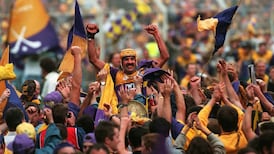This year's All-Ireland hurling club semi-finals line-up will feature three city clubs for the first time in 37 years and only the fourth time in the history of championship.
Cuala from Dublin, Limerick's Na Piarsaigh and Liam Mellows, who became the first city club in 33 years to win the Galway title, make up the last four together with Slaughtneil, the remarkable Derry club which for the second year running has won football, hurling and camogie titles in Ulster.
Paudie O'Neill, chair of the GAA's Hurling Development Committee (HDC) and former Tipperary coach, says that he had identified the possibility of three city clubs reaching the last four at the last meeting of the HDC a number of weeks ago even though the success of Liam Mellows wasn't at that stage considered likely.
He has personal links to the other two clubs in that having moved to Dublin he has been involved with Ballyboden St Enda’s for a number of years and is well aware of Cuala and has childhood memories of the other, Na Piarsaigh.
"I remember as a young fella growing up in Tipperary, my big summer holiday was to be sent to my aunt who was living in Limerick. Her husband was involved in Na Piarsaigh – this was 40, 45 years ago – and I remember going down to the field with him and Na Piarsaigh at that stage were just junior hurlers, a Ragball Rovers outfit – which shows what they have done in recent years."
The GAA in urban areas faces specific challenges. There is a greater concentration of other sports competing for the attention of a denser population, which is one of the balancing advantages of living in cities.
“It’s the intersection of two things,” says O’Neill of the rising profile of clubs from the major population centres.
"The first is the savage amount of work in urban areas. Coincidentally, I was aware of what Liam Mellows were doing because Mary Kenny, who was on the last HDC, is in that club and is a very good operator. I knew from her the amount of work that was going on.
Increasingly difficult
"The other thing is that we're coming to a tipping point in terms of demographics. Small clubs are definitely suffering from a lack of bodies. Look also for example in Waterford and Ballygunner have won the last four – a major population centre in Waterford city. It's becoming increasingly difficult for rural clubs to compete at that level.
“I was up in Ballygalget [in Down] at the weekend, a great club with a strong hurling and camogie tradition. Chatting to them, I was saying that in Ballyboden we’ve around 80 under-9s. There they probably have around 10.
“There’s also a trend that people from non-GAA backgrounds are getting involved and bringing fresh perspectives and different skill sets to clubs whereas often in rural areas the same families are involved from one generation to the next.
“It pulls the rug from under the notion that the game cannot be promoted in urban areas from start-ups.”
Mayo County Board has denied that it has given the go-ahead for a training camp during one of the weeks of April, the month which is dedicated in the new GAA calendar to club activities. The camp was included in a provisional fixtures list circulated to clubs but according to county PRO Paul Cunnane, the documents are for discussion.
“We need to get clarification from Croke Park as to how this closed season will operate,” he said, “but we haven’t made any decisions in relation to what happens next year. It will be fully discussed in the next couple of weeks.”
















